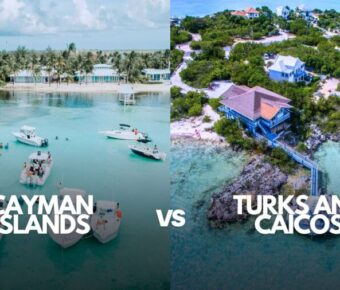
The 15 Best Vacations with Minimal Walking
Are you dreaming of a getaway but dreading the miles of walking that usually come with traveling? Good news – you can relax and explore without wearing out your legs. Whether you have mobility limitations or you simply prefer a slower pace, there are plenty of vacations that require little to no walking. Travelers with mobility issues often take far fewer trips than the average tourist, not for lack of wanderlust but due to accessibility concerns. It doesn’t have to be that way! From cruises to cabins, here are 15 fantastic low-walking vacation ideas that prove you can sightsee and have fun without straining your feet. Get ready to be inspired by enthusiastic yet easy-going adventures – no long hikes required.
Table of Contents
- 1. Set Sail on a Cruise — All Fun, No Footwork Required
- 2. Unwind at an All-Inclusive Resort — Everything Within Reach
- 3. Embark on a Scenic Road Trip — Enjoy Views from Your Vehicle
- 4. Ride the Rails on a Luxury Train — Travel in Total Comfort
- 5. Take a Guided Tour Package — See the Sights Without the Strain
- 6. Enjoy a Relaxing Staycation — Vacationing Right at Home
- 7. Discover Accessible City Escapes — Urban Adventures Made Easy
- 8. Bask in a Beach Getaway — Sun, Sand, and Almost No Walking
- 9. Cruise Down a River — Scenic Voyage Without the Walking
- 10. Indulge in a Spa Retreat — Rejuvenation Without Roaming
- 11. Visit Accessible Theme Parks — Thrills on Wheels, Little Walking
- 12. Go Wild on a Jeep Safari — Wildlife Viewing from Your Seat
- 13. Relax on a Houseboat Holiday — A Floating Home Base
- 14. Try Glamping or Cabin Stays — Comfort in Nature, No Hiking Needed
- 15. Embrace Virtual Travel — Explore the World from Your Couch
- Book Your Dream Experience
- More Travel Guides
1. Set Sail on a Cruise — All Fun, No Footwork Required
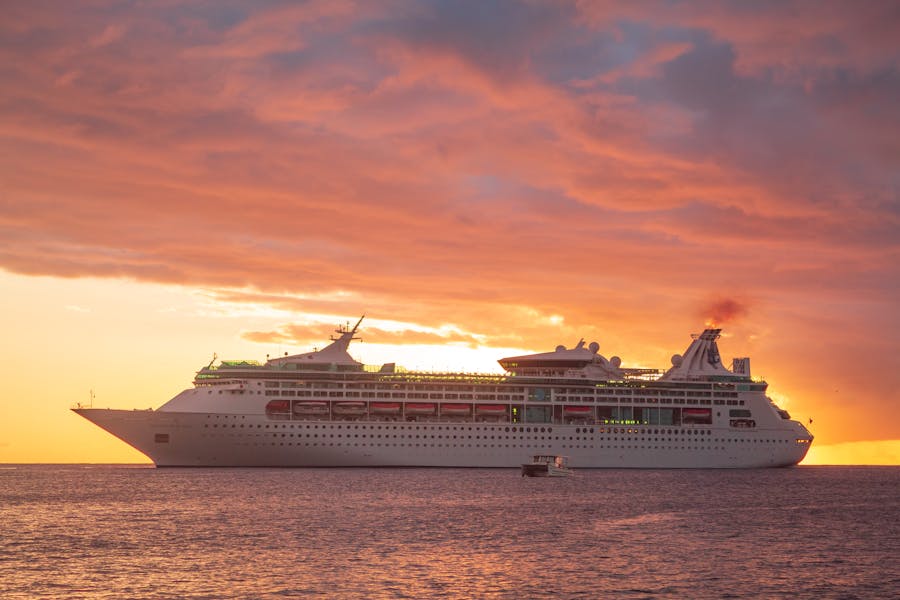
Imagine enjoying world-class entertainment, dining, and ocean vistas without ever needing to trek across town. On a cruise ship, everything you need is just steps or an elevator ride away. Cruise vacations are the ultimate effort-free adventure: you unpack once and the ship takes you from one destination to the next. You won’t be trudging down city blocks to find dinner – getting to the dining room can be as simple as hopping in an elevator. Modern cruise liners come equipped with plenty of accessibility features too, like ramps and roomy elevators, making them ideal if you have limited mobility.
- All-in-One Convenience: Ships are essentially floating resorts. Your room, restaurants, theaters, and pools are all in one place, so you can easily roll or stroll around at your own pace. You’ll never have to walk far for the next activity or meal.
- Accessibility: Many lines offer accessible staterooms (wider doorways, roll-in showers, etc.) for wheelchair users. Crew members are available to assist, and you can arrange priority boarding and support for shore excursions.
- Entertainment on Deck: From live shows to movie nights under the stars, you’ll have plenty of fun activities without leaving the ship. When a port stop comes, you can choose gentle excursion options (like bus tours) or simply enjoy the view from onboard if walking on shore is tough.
Cruising lets you relax completely – all fun, no footwork indeed. It’s no surprise that cruises are often the top recommendation for seniors or anyone seeking a vacation with minimal walking. Just pick a route (maybe a Caribbean jaunt or an Alaskan voyage) and set sail for a stress-free journey.
2. Unwind at an All-Inclusive Resort — Everything Within Reach
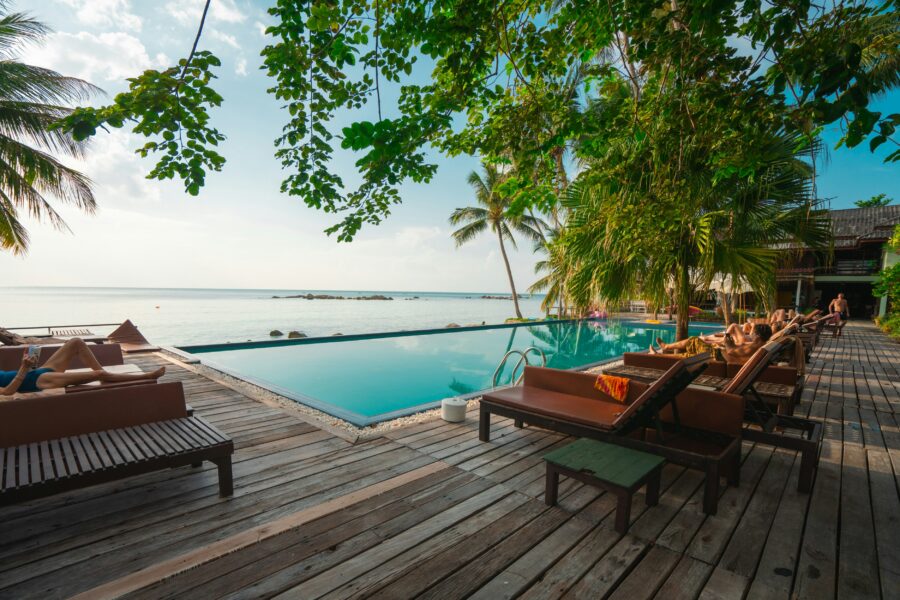
For a truly laid-back escape, head to an all-inclusive resort where the farthest you’ll roam is from your room to the pool. All-inclusive resorts bundle your accommodations, meals, activities, and entertainment in one location, so you can kick back without logistical worries. The best part? These resorts are designed so that everything is nearby – restaurants, beaches, and amenities are often just a short walk or shuttle ride away on the property.
All-inclusives come in many flavors, from tropical beach resorts to mountain spa lodges. What they share is convenience. Centrally located facilities and on-site services make them ideal for travelers with limited mobility. Many top resorts are wheelchair-friendly and ADA-compliant, offering features like ramps, ground-floor rooms, pool lifts, and even on-site medical staff or equipment rentals for guests who need them. You can spend your days lounging by the pool, enjoying buffet dinners, or joining in low-impact activities (think water aerobics or cultural shows) all without venturing far.
Travel Tip: When booking, look for resorts that advertise accessible or senior-friendly amenities. For example, some Caribbean and Mexican all-inclusives provide courtesy golf carts to shuttle guests around the property, so you won’t even have to walk between your room, restaurant, or the beach. Spa services, multiple dining options, and excursion desks are usually on-site, meaning you can plan outings (like a gentle boat tour or sightseeing drive) right from the resort. All-inclusive means your vacation literally comes to you – truly everything within reach for maximum relaxation.
3. Embark on a Scenic Road Trip — Enjoy Views from Your Vehicle
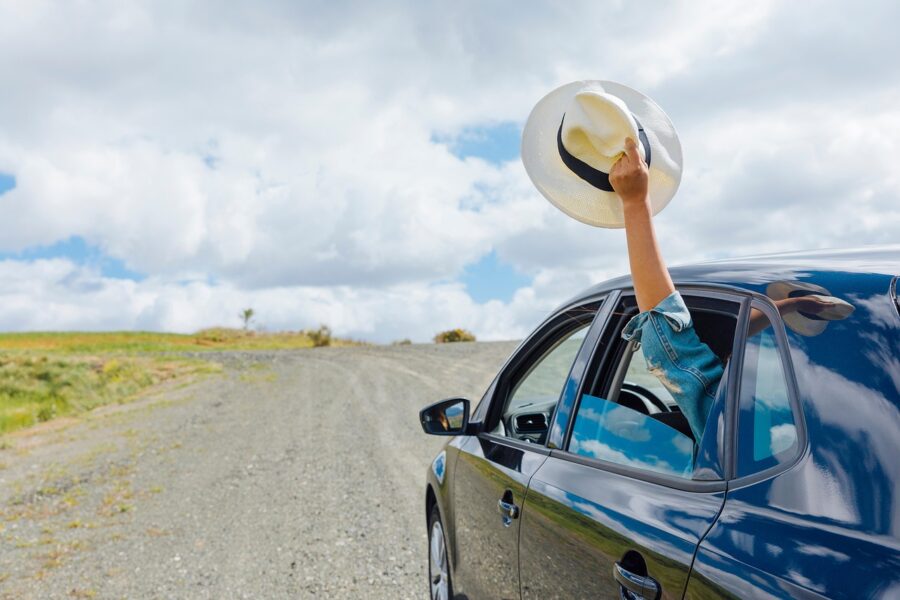
Who says you have to walk to explore? Hitting the open road can be one of the best low-walking vacations, because your car (or RV) does all the legwork. On a road trip, you can sightsee from the comfort of your seat, stopping at beautiful viewpoints and roadside attractions that involve minimal walking. This is a fantastic option if you love nature or varied scenery but can’t or don’t want to hike.
Plan a route through destinations that cater to drive-through sightseeing. For example, you might cruise down California’s Pacific Coast Highway, roll through the Grand Canyon’s scenic overlooks, or take a leisurely drive in the Great Smoky Mountains during fall foliage. National parks often have accessible viewpoints, boardwalks, or shuttle tours so you can enjoy the vistas with only short walks from the parking lot. You can tailor the trip to your energy level each day.
If you want extra ease, consider renting an accessible RV or camper van for your journey. Specialized rental services now offer RVs equipped with wheelchair lifts, tie-downs, and other adaptive features for travelers with disabilities. In fact, online platforms like Outdoorsy allow you to search specifically for ADA-compliant RV rentals and ask owners about any accommodations. Traveling by RV means you have your bed, bathroom, and kitchen on wheels, which minimizes the need to trek around for food or restroom stops. You can roll out of bed and be sightseeing right away!
During your scenic drive, be sure to pace yourself: take breaks, stretch, and soak in the views from overlooks. The beauty of a road trip is you’re on your own schedule. Whether it’s a coastal highway, a countryside village route, or a drive through wine country, a road trip lets you enjoy maximum scenery with minimal footwork. Just sit back, put on your favorite playlist, and enjoy the ride.
4. Ride the Rails on a Luxury Train — Travel in Total Comfort
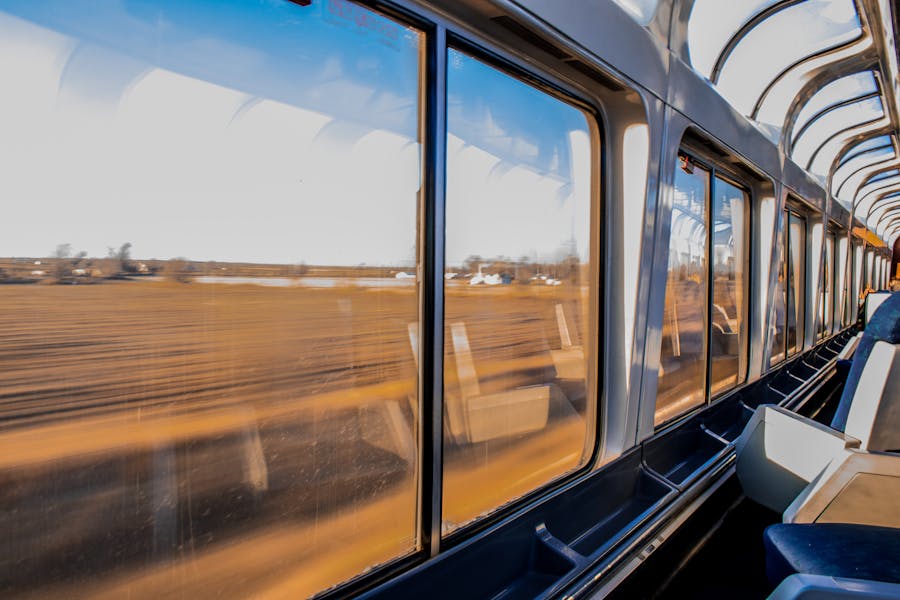
There’s something romantic and relaxing about a train journey – and it’s also a mobility-friendly way to travel. On a train vacation, you watch the world glide by your window while you lounge in a comfortable seat or sleeper berth. No cramped car rides, no navigating busy airports, and definitely no long walks (the train aisles are short!). Long-distance and scenic trains often have dining cars and observation lounges on board, so you can dine and sightsee without stepping off the train.
Many rail services are well-equipped for seniors and travelers with disabilities. For instance, Amtrak and other major rail lines offer accessible seating and restrooms on their trains. Some routes even have accessible sleeper cabins, so you can stay overnight on the train with ease. If you’re eyeing a bucket-list rail trip like the Rocky Mountaineer through the Canadian Rockies, good news – their SilverLeaf service has no stairs, and meals are served right at your seat for maximum convenience. In Europe, iconic trains like the Eurostar and Swiss scenic routes have modern accessibility features, making train travel one of the most inclusive ways to get around.
You can turn a train ride into the vacation itself. Scenic rail tours are available in many regions. Consider these examples of great low-walking train vacations:
- Cross-Country Rail Adventure: Take Amtrak’s cross-country route (like the California Zephyr or the Canadian VIA Rail) and watch diverse landscapes roll by, from mountains to prairies, all while relaxing in your seat or sleeper.
- European City Hopper by Train: Europe’s extensive rail network lets you city-hop without airport hassles. Enjoy a multi-city tour (e.g., London to Paris to Amsterdam) entirely by train – stations are centrally located, and you can catch taxis or accessible transit at each stop, minimizing walking.
- Luxury Scenic Trains: Indulge in a ride on a famous scenic train such as the Glacier Express in Switzerland or the Rocky Mountaineer in Canada. These journeys are designed for sightseeing, with large windows and slow, smooth routes. You’ll get jaw-dropping views of mountains, rivers, and forests, all from your cozy carriage.
Traveling by rail is about slowing down and savoring the journey. You’ll arrive at each destination well-rested, and you can often arrange transfers or tours upon arrival that keep things easy. For anyone seeking adventure without the physical strain, a luxurious train vacation is just the ticket.
5. Take a Guided Tour Package — See the Sights Without the Strain
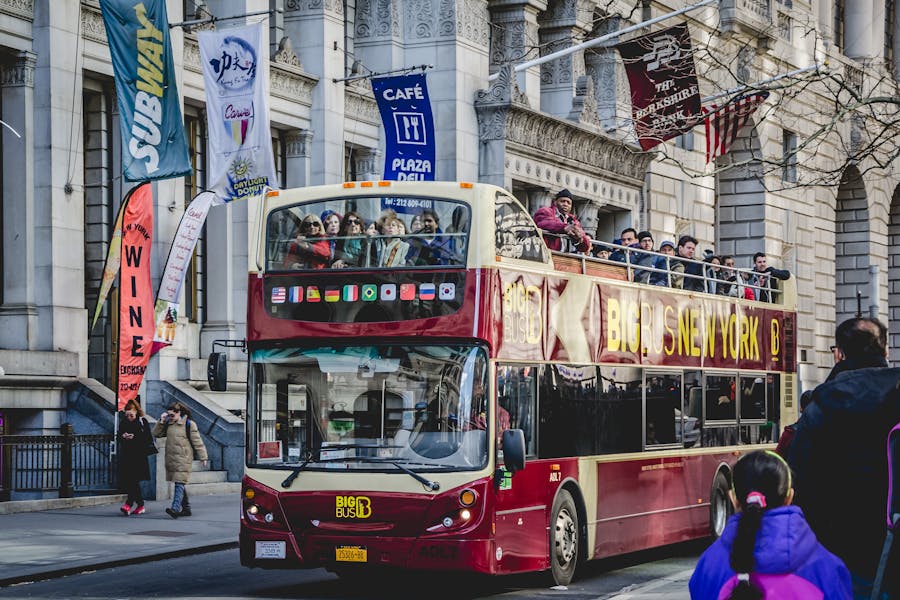
If planning and walking are not your idea of a vacation, why not let a tour company handle the details? Guided tour packages – whether by motorcoach, small van, or even cruise ship on land – are perfect for travelers who want to see new places with minimal walking and hassle. These tours typically provide transportation, accommodation, and a set itinerary of attractions, all led by a guide. Your job is simply to sit back and enjoy the ride.
Multi-day bus tours for seniors or people with limited mobility are increasingly popular. For example, you could join a coach tour of national parks, a cultural cities tour in Europe, or a fall foliage tour in New England. The tour bus drops you off right at the attractions, and many tours are designed with shorter walking distances or provide options like wheelchair lifts on buses and step stools to ease boarding. Some travel agencies even specialize in accessible travel – companies like Wheelchair Escapes or Prime Tours arrange trips where transportation and schedules are tailored for mobility needs. These agencies can take you anywhere from Alaska to the Mediterranean and ensure you won’t arrive only to find activities you can’t participate in.
On a guided tour, you’ll often benefit from:
- Door-to-Door Sightseeing: The tour vehicle takes you directly to each site, minimizing walking between spots. Many tours include priority entrances or tram rides within large attractions (for instance, touring a vast museum or park via guided electric cart instead of on foot).
- Luggage Handling: Forget hauling suitcases around. Tour staff typically handle your luggage at hotels, so you don’t need to walk far with bags.
- Built-In Breaks: Reputable tour companies know their guests’ needs. They schedule plenty of rest stops, restroom breaks, and even provide assistance during meals or free time if needed. It’s a stress-free way to travel, especially for seniors.
From European coach tours to African safari packages, there’s a guided trip for every interest. You’ll make new friends, learn from knowledgeable guides, and see amazing sights, all without the strain of organizing or over-exerting yourself. It’s travel made easy.
6. Enjoy a Relaxing Staycation — Vacationing Right at Home

Who says you need to go far to have a vacation? A staycation can be just as rewarding – and it completely eliminates any concern about walking long distances. The concept is simple: vacation at or near home, taking time off to relax and explore locally. The advantage is zero travel stress, no packing heavy bags, and you sleep in your own comfy bed each night.
A staycation is perfect if mobility issues make travel complicated, or if you just want to recharge without logistical hassles. There’s no rule that a great vacation must be in a far-flung place. By keeping it local, you keep stress low, costs down, and familiarity high. You can structure your staycation to be as active or as mellow as you like. For example:
- Be a Tourist in Your Town: Visit a local museum, botanical garden, or historic site that you’ve never seen (many cities have excellent accessibility in their major attractions). Because you’re nearby, you can take your time and maybe use your own mobility device or car to get around easily.
- Indulge at Home: Turn your home into a personal retreat. Perhaps you splurge on a backyard barbecue, set up a movie projector for a film night, or have a spa day at home. You could even hire a mobile massage therapist or rent a hot tub for a couple of days – all enjoyment with absolutely no walking required.
- Short Local Excursions: If you’re up for a tiny adventure, consider a short drive to a close-by scenic spot or an overnight in a local hotel with great amenities. For instance, book a weekend at a downtown hotel with a good view, order room service, and use the hotel pool. You get the feeling of a getaway without the travel fatigue.
The key to a successful staycation is breaking from routine. Take time off work, put aside chores, and focus on restful or fun activities. You’ll save money and energy. And when it’s over, there’s no exhausting journey home – you’re already there! A staycation proves that sometimes the best vacation spot is your own home and hometown, especially when easy comfort is the goal.
7. Discover Accessible City Escapes — Urban Adventures Made Easy
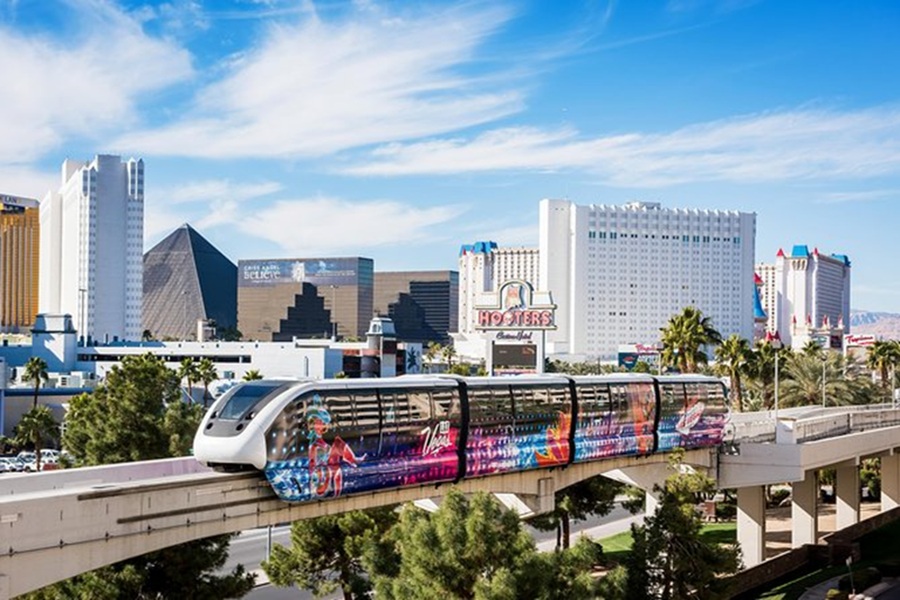
Think a city vacation has to mean miles of walking on concrete? Think again. Many cities are extremely well suited for low-mobility travelers, with excellent public transit, plentiful taxis or ride-shares, and compact attractions. An accessible city escape allows you to soak up culture, food, and sights with minimal walking by taking advantage of urban transportation and planning smartly.
The trick is to choose cities known for accessibility and transit options. For example, Las Vegas offers inexpensive monorails and trams along the Strip, so you can casino-hop or see shows without hoofing it (plus nearly every facility has elevators and ramps). Washington, D.C. has a great subway and bus system, and most of its famous monuments and museums are wheelchair-accessible (the Smithsonian museums even have free wheelchair rentals). Cities like San Diego, San Antonio, and Philadelphia feature compact downtowns or pedestrian zones with frequent benches and shuttles. And many large cities provide accessibility services like audible crosswalk signals and sidewalk curb cuts as standard. In fact, some of the best travel destinations for those who don’t want to walk much are big cities – they often have the infrastructure to help you get around easily.
Here’s how to make the most of a city trip with minimal walking:
- Use Public Transit and Shuttles: Research the city’s transit options. Many cities have hop-on hop-off tour buses, trolleys, or tram services that circuit popular attractions. These are fantastic for sightseeing without walking; you can ride to each stop, take a brief look, then ride again. Cities often also offer accessible subway or bus systems (for example, nearly all New York City buses are wheelchair-accessible and many London black cabs are, too).
- Stay in a Central Location: Pick a hotel in the heart of the city or near the sights you care most about. That way, you’re always a short distance away. You might choose an ADA-compliant hotel right by the museum district or next to a theater so your outings are minimal strolls or quick cab rides.
- Leverage Rideshare and Taxis: Don’t hesitate to use Uber, Lyft, or taxis even for short distances if it saves your feet. Many cities have wheelchair-accessible taxis or rideshare services as well. A five-minute cab ride can replace a 30-minute walk and make a world of difference in your energy.
Cities also often lead in accessibility innovation. You’ll find things like apps that locate accessible entrances, rental services for mobility scooters, and plenty of fellow travelers to give you tips. With thoughtful planning, an urban vacation can be thrilling and comfortable. From catching a Broadway show without climbing stairs, to rolling through a famous zoo on a guided tram, an accessible city adventure lets you enjoy the buzz of a new place without wearing out your sneakers.
(Examples of highly accessible cities include Las Vegas, NV and Orlando, FL for entertainment, Vienna and Singapore for public transport, and many others known for accommodating travelers of all abilities.)
8. Bask in a Beach Getaway — Sun, Sand, and Almost No Walking
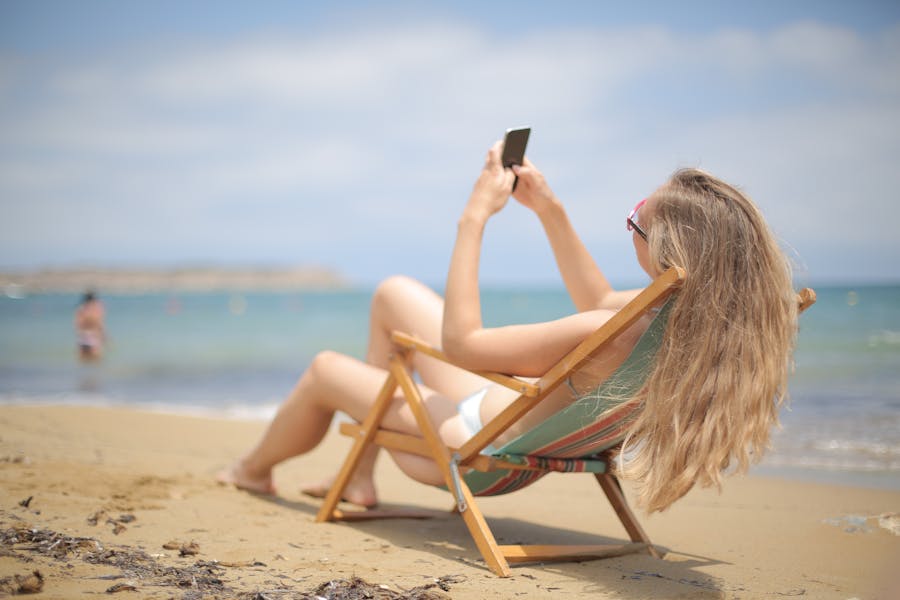
A beach vacation conjures images of gentle waves, a good book, and a comfy chair in the sand – which can be a wonderfully low-walking holiday if you plan it right. Instead of trudging through tourist sites, you’ll be planting yourself by the shoreline and letting relaxation wash over you. To minimize walking on a beach trip, the key is to stay close to the beach itself and choose locations that offer mobility aids or easy access.
Many beach towns and resorts understand that not everyone can or wants to trek across dunes. Look for beaches with boardwalks or beach mat pathways that extend over the sand, making it easier to reach the water. Some top beach destinations even provide beach wheelchairs or all-terrain wheelchair rentals for free or a small fee. For instance, in parts of Hawaii like Oahu, certain beaches (such as Ala Moana Beach) offer special wheelchairs with large tires so you can roll on the sand and even into shallow water. Florida’s Daytona Beach allows cars to drive on the sand in designated areas, meaning you can literally pull up to your beach spot without walking at all.
To enjoy a near-effortless beach holiday, consider these tips:
- Stay Beachfront: If possible, book a hotel or rental right on the beach. Being just a few steps from the sand means you can go back and forth easily. Ground-floor condos or hotels with beach shuttle service are even better – some places have golf carts to ferry guests around a resort or to the water’s edge.
- Accessible Beach Gear: Take advantage of available equipment. Many coastal destinations offer mobility aids like beach wheelchairs (as mentioned) or have ramps and paved promenades along the waterfront. Even a simple rolling cooler can save you carrying things back and forth. Pack your sun lotion, have the hotel staff set up a beach umbrella for you, and you’re set for the day.
- Choose Amenities Nearby: Opt for beaches that are near amenities like restaurants, restrooms, and shops. Boardwalk areas (for example, Santa Monica, CA or Virginia Beach, VA) are great because you can enjoy the ocean and then roll or stroll a short distance to grab a snack or use a restroom – no long sandy hikes. Some beaches even have pier access where you can enjoy ocean views from a smooth, flat surface.
Once you’re settled in your lounge chair listening to the waves, you’ll appreciate how rejuvenating a beach getaway can be with minimal movement. Swim a bit, nap a bit, watch the sunset – and when you’re ready, you’re only a short meander from your room. It’s sun and surf on your own terms, perfect for a low-exertion escape.
9. Cruise Down a River — Scenic Voyage Without the Walking
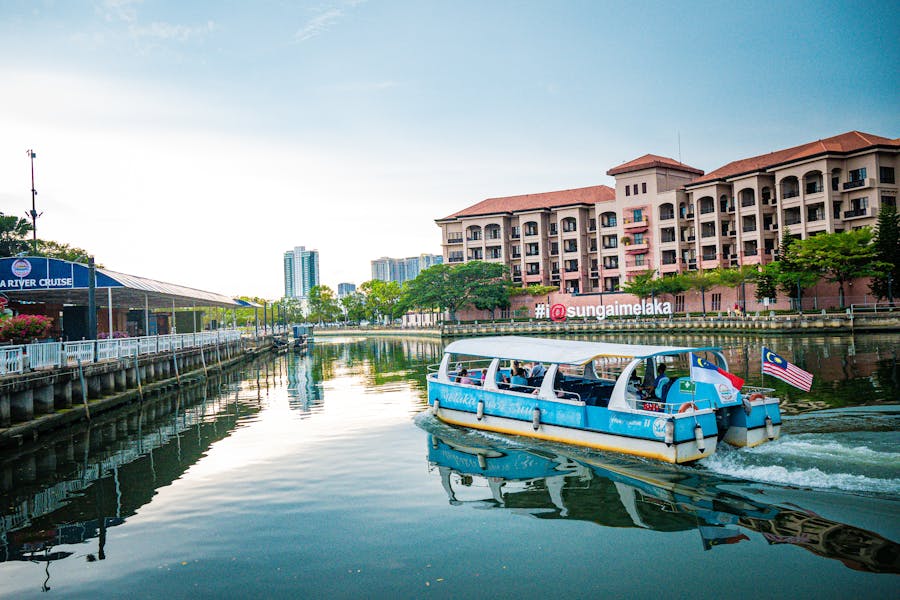
We’ve covered ocean cruises, but don’t overlook the charm of a river cruise for an easy, minimal-walking adventure. River cruises are usually on smaller ships that navigate inland waterways – picture floating gently past castles on the Rhine or through the lush landscapes along the Mississippi. Because these ships are more intimate, you’ll deal with shorter walking distances on board (smaller boats = everything is close by). Plus, they often dock right in the heart of towns and villages, so if you do decide to sightsee on land, it’s a quick walk or roll into town.
A river cruise offers all the same core benefits as an ocean cruise: your room, dining, and entertainment travel with you, eliminating the need for lots of walking or transfers. In fact, river cruising can be even more laid-back. There are no huge crowds or endless decks to traverse; it’s a cozy environment. For travelers with mobility concerns, river cruises can be ideal – many vessels have elevators and accessible cabins, and crew assistance is readily available. River cruise companies (like Viking, AmaWaterways, etc.) often note which itineraries are best for limited mobility. They might offer gentle shore excursion options (like panoramic bus tours or shorter walks) at each port.
The scenery is a big highlight: you can enjoy continuous views of landscapes right from the ship’s lounge or your private balcony. Imagine gliding by storybook villages, watching wildlife on the riverbanks, or floating under city bridges at sunset, all without moving your feet. It’s like an moving panorama outside your window.
For a no-walking-required experience, you could even stay on board during port stops and simply appreciate the destination from the deck. But if you’re up for a brief outing, the excursions are typically very accessible – think wine tasting at a vineyard a short bus ride from the dock, or a guided canal boat tour in a European city (where you sit the whole time). River cruises truly marry travel and comfort, giving you the freedom to explore at your own gentle pace. As one travel expert notes, these smaller cruises provide a relaxed way to visit picturesque places with all the needed amenities close at hand. All aboard for tranquility!
10. Indulge in a Spa Retreat — Rejuvenation Without Roaming
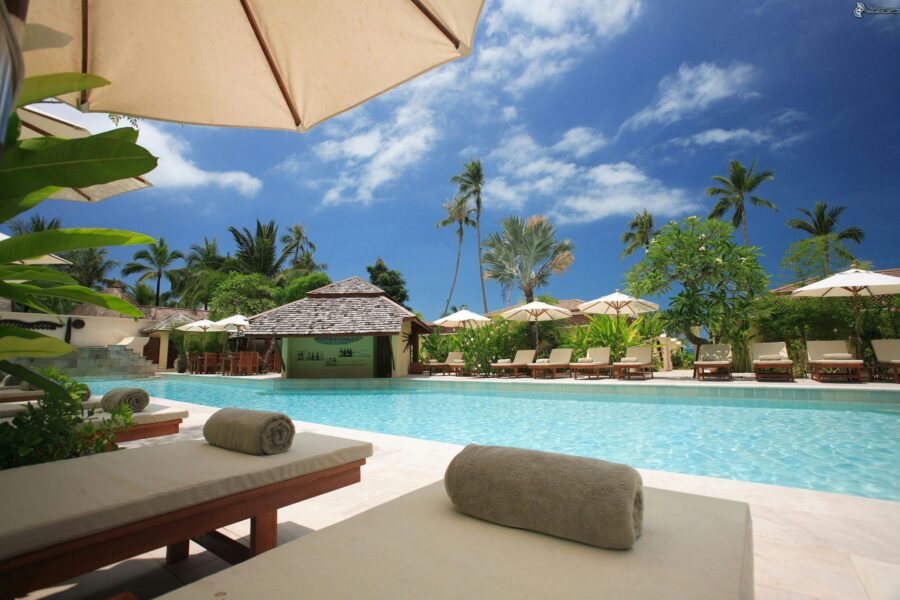
If your idea of bliss is being pampered rather than running around sightseeing, then a spa or wellness retreat might be your perfect minimal-walking vacation. At a spa resort, the goal is to relax, rejuvenate, and recharge – which mostly involves sitting or lying down while enjoying soothing treatments. Sounds pretty foot-friendly, right?
Spa retreats come in various styles. You might choose a destination spa in a serene location (like the mountains or desert), where all you’re “required” to do is slip on a robe and show up for your massage or mineral soak. Many such resorts are compact and fully equipped with facilities so that you hardly need to leave the building: rooms, restaurants, and treatment areas are under one roof or in connected buildings. Some even have accessible shuttles or golf carts to ferry guests around the grounds if the property is large. The staff is usually very attentive to special needs, so you can request assistance or modifications to make your stay comfortable.
Here’s what a typical day on a spa vacation might look like (with virtually no walking necessary): You start with a healthy breakfast on-site, then perhaps head to a yoga or stretching class where everything is provided for you. Next, you shuffle over to the spa (often just an elevator ride away) for a scheduled massage or aromatherapy session. Afternoon could be spent lounging by a tranquil pool or soaking in a hot tub. In the evening, you enjoy a gourmet dinner right at the resort’s restaurant. No rushing around town, no long walks – every activity is designed to be calming and easy to get to.
Many spa resorts also offer additional wellness activities like meditation sessions, art therapy, or cooking classes, usually in the same facility. So if you want to participate, it’s just a short walk down the hall. If you’d rather do absolutely nothing, that’s fine too! The point of a spa retreat is that there’s no pressure to be on the go. You’ll have plenty of places to simply sit and enjoy a view or read a book (gardens, lounges, etc., often with accessible pathways and comfy seating).
When booking a spa or wellness retreat, look for keywords like “all-inclusive spa”, “accessible facilities”, or “senior-friendly resort.” Some renowned spa destinations (for example, Sedona, Arizona or Bali, Indonesia) cater to guests of all ages and abilities – they often have staff to help you navigate and offer personalized schedules so you can maximize relaxation. At the end of this vacation, you should feel renewed rather than exhausted. Your body and your feet will thank you for choosing rejuvenation over roaming.
11. Visit Accessible Theme Parks — Thrills on Wheels, Little Walking

You might not immediately think “theme park” when considering low-walking vacations, but with the right planning, even places like Disney World can be enjoyed with minimal walking. Modern theme parks offer a variety of services for guests with mobility limitations – from wheelchair and scooter rentals to skip-the-line programs – ensuring you can experience the fun and excitement with far less footwork than you’d expect.
Take Walt Disney World in Florida for example: it’s exceptionally well-equipped for visitors with disabilities, often going above and beyond to accommodate everyone. Every park has wheelchair rental locations near the entrance, and most rides have accessible queues or alternate entrances so you don’t have to stand (or can queue in a wheelchair) for long periods. There are passes like the Disability Access Service (DAS) which allow those who qualify to get a return time for rides instead of waiting in physical lines. Additionally, Disney (and many other parks) provide continuous transportation – buses, monorails, or ferries – that are accessible, so moving between park areas or even between your hotel and the park requires minimal walking on your part.
Here are strategies to enjoy a theme park with minimal walking:
- Rent a Mobility Aid: Even if you can walk short distances, consider renting an ECV (electric convenience vehicle/scooter) or wheelchair at the park. This immediately saves your energy. You can drive/roll right up to most attractions. In many cases, you can stay in your wheelchair for shows and certain rides, or transfer at the ride seat with cast members assisting.
- Plan Your Day Smartly: Take advantage of shows, parades, and restaurants as built-in breaks. For instance, watch an indoor theater show (air-conditioned rest!) or schedule a leisurely character dining meal. These give you enjoyable experiences while sitting down. Also, visit in the off-season or weekdays if possible – fewer crowds mean less walking around people and shorter distances to maneuver in queues.
- Use Accessibility Services: Don’t be shy to ask Guest Services about all available accommodations. Many parks have guides for guests with mobility disabilities. They might offer special viewing areas for parades (so you don’t have to stand early to see), wheelchair-accessible ride vehicles on select attractions, or transportation within the park (like Disneyland’s railroad or shuttle boats within large parks). By using these, you can cover ground without foot effort.
Other theme parks and attractions – such as Universal Studios, SeaWorld, zoos, and aquariums – also provide similar services. Often, these places allow one companion to accompany the person with a disability through alternate entrances, so your family or friends can stick together with less walking too. The bottom line: you can absolutely enjoy the thrills of theme parks “on wheels”. Many visitors do it every day, and parks are continuously improving to be inclusive. So go ahead and feel like a kid again, without worrying about long treks from one rollercoaster to the next.
12. Go Wild on a Jeep Safari — Wildlife Viewing from Your Seat
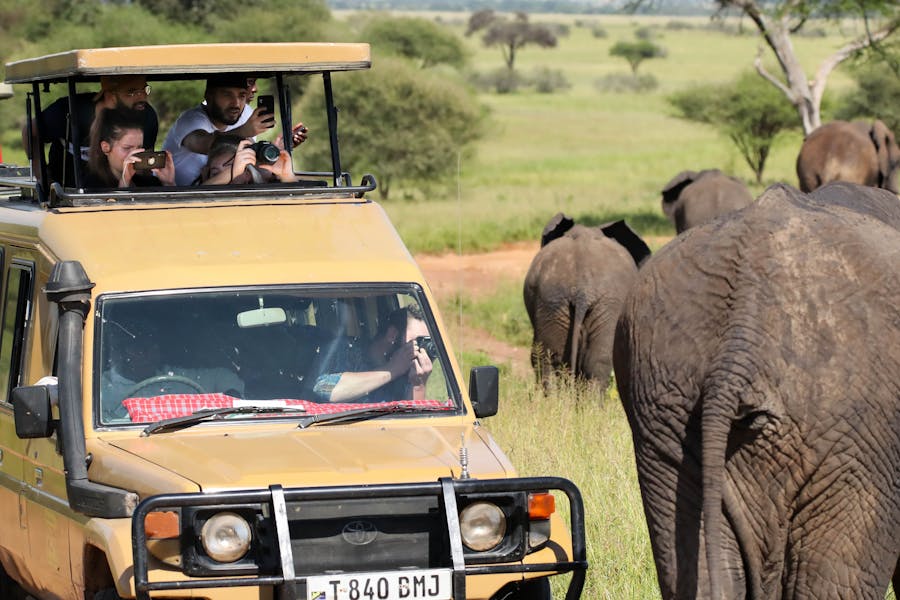
Dream of seeing lions, elephants, or other incredible wildlife up close, but not keen on trekking through jungles? A jeep safari could be your ideal adventure. Safari tours, especially in Africa or other wildlife-rich regions, typically involve riding in a 4×4 vehicle to spot animals, meaning you spend most of your time seated comfortably while the stunning scenery and creatures come to you. It’s an exhilarating experience that requires very little walking – and it can be adapted to various mobility levels.
Classic African safaris in places like Kenya, Tanzania, or South Africa usually have you in a guided jeep for morning and evening game drives. You’ll be driven through national parks or private reserves, with an expert guide pointing out wildlife. All you need to do is hold on (when off-roading) and gaze at the surroundings – no hiking necessary. Many lodges and safari outfits are quite accustomed to older travelers or those who need assistance. In fact, some safari lodges and tour companies specialize in wheelchair-accessible safaris, with vehicles that have lifts or easy step access and accommodations designed for accessibility. For example, certain safari trucks in Botswana and South Africa can clamp in wheelchairs securely so you can roll onboard and stay in your chair during the drive. Boats and even canoe experiences can be adapted too, allowing you to explore rivers or deltas without leaving your seat.
What’s great about safaris is that the excitement comes to you. You might be parked under an acacia tree and see a pride of lions lounging, or slowly driving past a watering hole teeming with elephants bathing – all while you’re comfortably in the vehicle. Photographers love it because you have your equipment with you, no long treks needed for that perfect shot. Typically, the only walking might be around the lodge grounds or short distances at rest stops, and even those are often optional.
To make a safari even more low-exertion, consider these tips:
- Choose Accessible Lodges: Research safari camps known for being mobility-friendly – many in popular regions advertise features like ground-level tents, roll-in showers, and boardwalk paths instead of rough terrain. Some even provide personal attendants to assist guests as needed.
- Private or Custom Tours: If joining a big group seems daunting, you can book a private safari guide/vehicle. That way, you can dictate the pace: stop for breaks when you need, skip any bush walks or climbing activities, and ensure you have help for getting in and out of the jeep. The guide can position the vehicle for the best views without you needing to move around.
- Combine with Light Touring: Often safari trips start and end in a city (like Nairobi or Johannesburg). You can request a light city tour by car if you want to see some culture or shopping without foot travel. Many tour operators are happy to arrange accessible city highlights to complement the wildlife part.
A safari is truly a bucket-list trip, and it’s heartening to know it’s very achievable even if you can’t walk far. The wilderness is surprisingly accessible when experienced from a well-equipped jeep. So get your camera ready and check this off your list – the only “hiking” you’ll do is maybe climbing into the Land Rover, and then it’s pure wild magic from there on out.
13. Relax on a Houseboat Holiday — A Floating Home Base
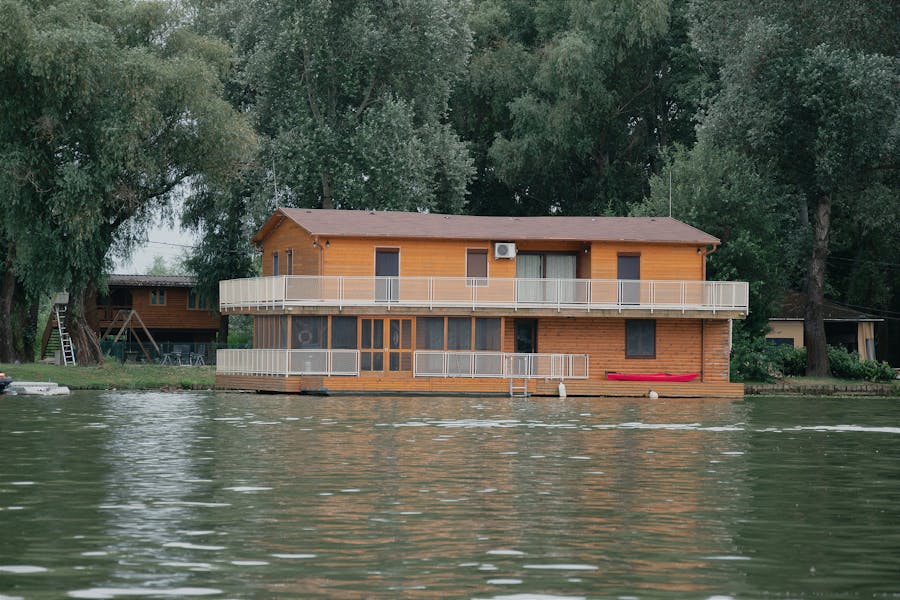
For a completely different kind of retreat, consider renting a houseboat and spending your vacation afloat. A houseboat holiday means your accommodation is the attraction – you’ll be gently bobbing on a lake, river, or canal, enjoying nature right from your deck. It’s the ultimate “cabin by the water” experience, and it involves very little walking because your living space, dining area, and leisure spots (deck chairs, anyone?) are all onboard.
Houseboats come in various sizes, but many are essentially like a small apartment on water, often single-level or with only a few steps. If you have some mobility but want to avoid long walks, once you’re on the houseboat you won’t need to go far for anything. Eat, sleep, read, fish, stargaze – all in one cozy spot. Some houseboats are even specifically designed to be accessible for wheelchair users or those with limited mobility. For instance, there are rental houseboats with wide doorways, ramps instead of stairs, and accessible bathrooms. One European houseboat model, the Febomobil, is certified for travelers with reduced mobility and basically combines a vacation home and boat into one, making it easy to enjoy the water without barriers.
How a houseboat vacation typically works: you rent the boat at a marina and receive a little training on how to pilot it (don’t worry, they are generally slow and simple to operate, no special license needed in many places). Then you set off at a leisurely pace on the waterway. You can dock at various points if you want to go on land for a brief exploration or supply run, or you might just anchor in a scenic cove and not move for days – it’s up to you. If you do dock near a town, you can often arrange for a taxi or have supplies delivered to the marina so you don’t have to walk far to get what you need.
Some wonderful aspects of a houseboat holiday include:
- Ever-Changing Scenery: Without walking a step, you can have new views outside your window each day. This could be forested shorelines, cliffs, lakeside villages, or open water vistas. Enjoy your morning coffee with sunrise over the lake and dinner with sunset reflecting on the waves.
- Activities from the Boat: You can fish right off your deck, dip into the water for a swim (ladder provided), or use a kayak/canoe stored on the houseboat for a short paddle if you feel up to it. These are optional of course – you can equally just sunbathe on the top deck with a cold drink.
- Quality Time: A houseboat trip is usually done with family or close friends in a very relaxed atmosphere. It’s great for togetherness. You’ll play board games, chat, cook simple meals – all in a compact space. No one is rushing off anywhere far. It’s slow travel at its finest.
Do keep in mind that someone will need moderate ability to handle the boat’s basics, but many tasks can be done by the more able-bodied in your group while you supervise or relax. If you prefer not to pilot it yourself, some companies in places like the Netherlands, Kerala (India), or the Mississippi River offer houseboat tours with a crew – then you truly don’t have to lift a finger.
A floating vacation home provides freedom with comfort. You’re not confined to a hotel room, but you also don’t have to navigate large distances to enjoy your holiday. If you love water and tranquility, a houseboat might be your perfect minimal-walking getaway.
14. Try Glamping or Cabin Stays — Comfort in Nature, No Hiking Needed
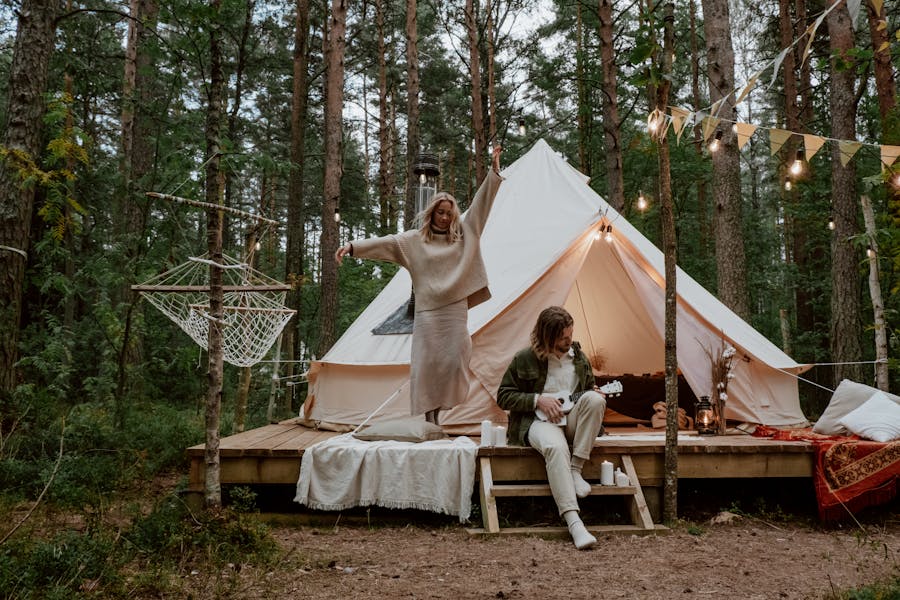
Craving some fresh air and nature views without roughing it or trekking around? Glamping (glamorous camping) or renting a cozy cabin could strike the ideal balance. These options let you immerse yourself in the great outdoors with the comforts of home, meaning you can enjoy nature at your doorstep without embarking on long hikes or setting up complicated campsites. It’s like camping minus the hard parts – perfect for a low-mobility vacation that’s still rich in scenery and relaxation.
Glamping usually involves staying in a furnished tent, yurt, treehouse, or similar unique lodging that comes equipped with real beds, sometimes private bathrooms, and often electricity and heat. Many glamping sites are designed to be accessible and hassle-free – you arrive and everything is ready for you. Some even have ramps, wide entrances, and spacious interiors to accommodate wheelchairs or walkers. The idea is that you get to enjoy things like a campfire, stargazing, and morning birdsong without needing to trek into remote wilderness or deal with uneven ground. In fact, several glamping resorts advertise that you can experience the outdoors “your way, at your pace, with comfort guaranteed.” That means if you want to just sit on a deck and gaze at mountains or a lake, that’s absolutely encouraged!
Similarly, renting a cabin or cottage in a scenic area gives you a homey base where you can be in nature 24/7 but do as little physical activity as you like. Look for cabins that are described as accessible or step-free if needed – many state park systems and private rentals have cabins with features like ramps, roll-in showers, or single-story layouts for those with limited mobility. Once you’re at the cabin, you can enjoy simple pleasures: cook out on the porch (no hunt for restaurants), have a picnic right outside, or drive to a viewpoint for sunset then come back to your cabin to relax.
Some tips to make glamping or cabin stays enjoyable with minimal walking:
- Pick the Right Site: Research how far your lodging is from parking and amenities. Many glamping sites will allow you to park right next to your tent or hut, so unloading and moving around is easy. If the site has communal facilities (like a dining hall or bathhouse), try to get a tent or cabin close to those, or one with a private bathroom to avoid extra walks.
- Leverage On-Site Activities: A lot of these nature retreats offer on-site activities that require little movement. For example, there might be a fire pit for storytelling evenings, lawn games you can play seated, or even guided wildlife watching from a platform near the camp. You might be able to join a short nature talk or star-gazing session literally steps away from your lodging.
- Mobility Aids for Outdoors: If uneven ground is a concern, consider using trekking poles for stability or an all-terrain wheelchair if you have one (some parks rent them). Many cabins have paved or packed pathways. And remember, you can always enjoy nature drives: take a short car ride through a scenic loop road during the day, then spend the rest of your time relaxing at the cabin.
Glamping and cabin trips let you tap into the peaceful vibe of nature without the “forced march” that some outdoorsy trips entail. You’ll wake up to birds chirping and go to sleep after roasting marshmallows under the stars, all with a comfortable bed nearby. It’s proof that you can have an authentic nature vacation with barely any walking – Mother Nature comes to you.
15. Embrace Virtual Travel — Explore the World from Your Couch

Finally, here’s an unconventional “vacation” idea that literally requires no walking at all (and no traveling either, in the physical sense): try a virtual travel experience. While it’s not a traditional vacation, virtual tourism has exploded in recent years and can be surprisingly immersive and enjoyable, especially if health or circumstances prevent you from going far. You can tour world-famous sites, wander museums, and even experience a bit of adventure all through a screen or VR headset, right from the comfort of your living room.
How do you “travel” virtually? There are several ways:
- Virtual Tours of Landmarks: Many popular tourist attractions offer free virtual tours online. For example, you can explore the Louvre Museum in Paris via a 360-degree online tour, stroll through the corridors of the Vatican Museums, or climb the Great Wall of China through a virtual walk-through video. These tours often allow you to click arrows to move through spaces as if you’re there, and some include audio guides.
- Travel Documentaries and Livecams: Queue up a high-quality travel documentary or a live webcam feed. You could watch a series that tours different countries (with stunning visuals in HD) or check live webcams from a African watering hole, a tropical beach, or Times Square – giving you the sights and sounds in real time. It’s surprisingly fun to “people-watch” or nature-watch via webcams.
- Virtual Reality (VR) Adventures: If you have access to a VR headset, the possibilities widen further. There are VR apps that let you ride a virtual roller coaster, scuba dive in a coral reef, or walk around ancient ruins reconstructed in 3D. It’s incredibly engaging – you can look around in any direction and feel transported. Even without VR, 360° videos on YouTube (which you can pan around with a mouse or phone) let you experience things like a helicopter ride over the Grand Canyon or a safari drive-by of elephants.
While virtual travel might not replace the feeling of real sun on your face, it opens up the world in a unique way, especially useful for armchair travelers or those who cannot undertake a physical trip. You can “visit” places that might have been off-limits due to mobility constraints – think of it as scouting for future real trips or just fulfilling some wanderlust from home. An added bonus: it’s extremely budget-friendly and you can “travel” from one country to another in seconds!
For a fulfilling virtual vacation, set the mood: perhaps make a meal or order takeout inspired by the destination you’re “visiting,” and schedule video-chat check-ins with friends or family to share your experiences. You might be surprised at how engaged you feel. Virtual travel can spark joy and curiosity, all without any walking – or flying – required.
Don’t let limited mobility or a dislike of walking stop you from seeing the world or enjoying a break. As we’ve shown, there are plenty of vacations where your feet can take a back seat while you still soak up new experiences, relaxation, and fun. From cruises and road trips to safaris and spa days, the options span every travel style – and each can be tailored to your comfort level. The best part is that these ideas are not only great for those with physical limitations, but also for anyone who simply wants a more laid-back, less hurried vacation.
Life’s too short to sit at home wishing you could travel. With a bit of planning and the right kind of trip, you can absolutely have an adventure that’s both accessible and deeply rewarding. So pick one of these minimal-walking vacations, and get ready to create wonderful memories without wearing out your shoes. Happy travels (or happy relaxing)!


